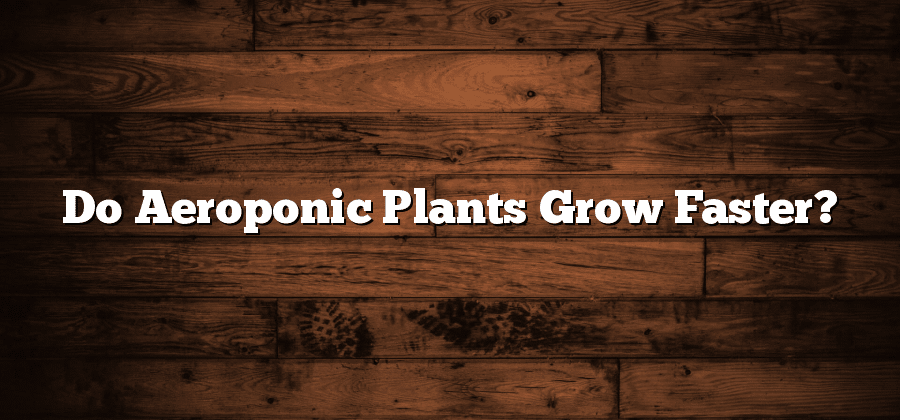Advantages of Aeroponic System
One of the notable advantages of the aeroponic system is its ability to conserve water. Compared to traditional soil cultivation methods, aeroponics use up to 95% less water. This is possible because plants in an aeroponic system are only misted with a nutrient-rich solution, allowing them to absorb what they need efficiently. The remaining solution that is not absorbed is collected and recirculated, minimizing water waste. This water-saving feature makes aeroponics an attractive option for regions experiencing water scarcity or those striving for sustainable agriculture practices.
Another advantage of the aeroponic system is its ability to maximize plant yield. In this system, the roots are suspended in the air, allowing them to access higher levels of oxygen. This oxygenation promotes faster and healthier growth, resulting in larger and more robust plants. Additionally, since the plants are not constrained by soil, their roots can freely access nutrient-rich mist, enhancing nutrient absorption. These factors combined contribute to higher crop yields compared to traditional soil cultivation methods. This increased productivity makes the aeroponic system an excellent choice for commercial farming, where maximizing output is crucial for profitability.
Factors Affecting Plant Growth in Aeroponics
Factors Affecting Plant Growth in Aeroponics:
Aeroponics, being a soilless method of cultivation, presents unique factors that can significantly influence plant growth. First and foremost, the quality of the nutrient solution plays a crucial role in determining plant health. Since plants are deprived of soil, it becomes imperative to provide them with a well-balanced and nutritionally rich solution. Without adequate nutrients, plants may suffer from deficiencies or become more susceptible to diseases.
Another factor that affects plant growth in aeroponics is the management of oxygen levels. As plants are suspended in air and their roots are constantly exposed, proper oxygenation is vital for their survival. Insufficient oxygen supply can lead to root rot, hindering the plant’s ability to absorb nutrients effectively. Hence, ensuring a continuous supply of oxygen is essential to promote healthy root development and overall plant growth in aeroponic systems.
Understanding these factors can help aeroponic growers optimize plant growth by providing the ideal nutrient solution and ensuring adequate oxygenation. In the next section, we will compare aeroponics with traditional soil-based cultivation methods to further explore the advantages that this innovative technique offers.
Comparison with Traditional Soil Cultivation
Aeroponic system is a revolutionary method of plant cultivation that offers several advantages over traditional soil cultivation. Unlike traditional soil cultivation, aeroponics eliminates the need for soil altogether and allows plants to grow in a nutrient-rich misted environment. This method ensures that plants receive the necessary nutrients directly to their root systems, promoting healthier and faster growth. Unlike in soil cultivation, where plants compete for nutrients, aeroponics provides a controlled environment where each plant receives an equal distribution of nutrients. Additionally, aeroponic systems allow for better oxygenation, as the roots have ample access to fresh air and oxygen. This not only enhances the overall growth rate but also supports the development of stronger and more robust plants.
In contrast, traditional soil cultivation has limitations that can impede plant growth. Soil quality varies, and not all soils are capable of providing the necessary nutrients and water retention capacity for optimal plant growth. This can result in stunted growth and decreased yield. Moreover, soil-borne diseases and pests can pose significant threats to plant health, often requiring the use of pesticides or other chemicals. These chemicals can have long-term negative effects on the environment and human health. In traditional soil cultivation, plants may also face nutrient deficiencies or imbalances, depending on the soil composition, which can affect the overall quality of the produce.
Nutrient Delivery in Aeroponics
Nutrient delivery is a crucial component of aeroponic systems, as it directly affects the growth and development of plants. Unlike traditional soil cultivation, where nutrients are slowly absorbed by plants through the roots, aeroponics provides a more efficient and direct method of delivering nutrients. In aeroponic systems, plant roots are exposed to a fine mist or spray of nutrient-rich solution, allowing for rapid absorption and utilization of essential elements.
The nutrient delivery process in aeroponics offers several advantages. Firstly, it ensures that plants receive a balanced and controlled supply of nutrients, avoiding the risk of over or under-feeding. This precision allows for optimal growth and development, resulting in healthier and more productive plants. Secondly, the fine mist delivery system promotes increased oxygenation of the root zone, further enhancing nutrient uptake and overall plant vigor. By delivering a consistent and oxygen-rich stream of nutrients, aeroponics maximizes plant efficiency and minimizes resource wastage.
Oxygenation in Aeroponic Systems
A crucial aspect of aeroponic systems is the provision of adequate oxygenation for plant roots. In traditional soil cultivation, plants rely on air pockets within the soil for oxygen supply. However, in aeroponics, where plants are grown without soil, a different approach is required to ensure sufficient oxygen reaches the roots. The highly oxygenated environment in aeroponic systems provides several benefits for plant growth and overall plant health.
Firstly, the oxygen-rich conditions in aeroponics promote the development of stronger and healthier root systems. As the roots are suspended in air, they have unrestricted access to oxygen, leading to enhanced nutrient uptake and photosynthetic efficiency. This often results in faster and more vigorous plant growth compared to traditional soil cultivation methods. Moreover, the increased availability of oxygen helps prevent the growth of anaerobic pathogens and diseases, creating an environment that is less prone to root rot and other soil-borne ailments.






